Potřebujeme váš souhlas k využití jednotlivých dat, aby se vám mimo jiné mohly ukazovat informace týkající se vašich zájmů. Souhlas udělíte kliknutím na tlačítko „OK“.
ASTM E2760-10e2
Standard Test Method for Creep-Fatigue Crack Growth Testing (Includes all amendments And changes 1/4/2017).
Automaticky přeložený název:
Standardní zkušební metoda pro testování Creep-únavových trhlin růstu
NORMA vydána dne 1.5.2010
Informace o normě:
Označení normy: ASTM E2760-10e2
Poznámka: NEPLATNÁ
Datum vydání normy: 1.5.2010
Kód zboží: NS-45996
Počet stran: 19
Přibližná hmotnost: 57 g (0.13 liber)
Země: Americká technická norma
Kategorie: Technické normy ASTM
Kategorie - podobné normy:
Anotace textu normy ASTM E2760-10e2 :
Keywords:
compact specimens, cracks, crack growth, creep, fatigue, metals, ICS Number Code 77.040.10 (Mechanical testing of metals)
Doplňující informace
| Significance and Use | ||||||||||||||||||||||
|
Creep-fatigue crack growth testing is typically performed at elevated temperatures over a range of frequencies and hold-times and involves the sequential or simultaneous application of the loading conditions necessary to generate crack tip cyclic deformation/damage enhanced by creep deformation/damage or vice versa. Unless such tests are performed in vacuum or an inert environment, oxidation can also be responsible for important interaction effects relating to damage accumulation. The purpose of creep-fatigue crack growth tests can be to determine material property data for (a) assessment input data for the damage condition analysis of engineering structures operating at elevated temperatures, (b) material characterization, or (c) development and verification of rules for design and life assessment of high-temperature components subject to cyclic service with low frequencies or with periods of steady operation, or a combination thereof. In every case, it is advisable to have complementary continuous cycling fatigue data (gathered at the same loading/unloading rate), creep crack growth data for the same material and test temperature(s) as per Test Method E1457, and creep-fatigue crack formation data as per Test Method E2714. Aggressive environments at high temperatures can significantly affect the creep-fatigue crack growth behavior. Attention must be given to the proper selection and control of temperature and environment in research studies and in generation of design data. Results from this test method can be used as follows: Establish material selection criteria and inspection requirements for damage tolerant applications where cyclic loading at elevated temperature is present. Establish, in quantitative terms, the individual and combined effects of metallurgical, fabrication, operating temperature, and loading variables on creep-fatigue crack growth life. The results obtained from this test method are designed for crack dominant regimes of creep-fatigue failure and should not be applied to cracks in structures with wide-spread creep damage. Localized damage in a small zone around the crack tip is permissible, but not in a zone that is comparable in size to the crack size or the remaining ligament size. |
||||||||||||||||||||||
| 1. Scope | ||||||||||||||||||||||
|
1.1 This test method covers the determination of creep-fatigue crack growth properties of nominally homogeneous materials by use of pre-cracked compact type, C(T), test specimens subjected to uniaxial cyclic forces. It concerns fatigue cycling with sufficiently long loading/unloading rates or hold-times, or both, to cause creep deformation at the crack tip and the creep deformation be responsible for enhanced crack growth per loading cycle. It is intended as a guide for creep-fatigue testing performed in support of such activities as materials research and development, mechanical design, process and quality control, product performance, and failure analysis. Therefore, this method requires testing of at least two specimens that yield overlapping crack growth rate data. The cyclic conditions responsible for creep-fatigue deformation and enhanced crack growth vary with material and with temperature for a given material. The effects of environment such as time-dependent oxidation in enhancing the crack growth rates are assumed to be included in the test results; it is thus essential to conduct testing in an environment that is representative of the intended application. 1.2 Two types of crack growth mechanisms are observed during creep/fatigue tests: (1) time-dependent intergranular creep and (2) cycle dependent transgranular fatigue. The interaction between the two cracking mechanisms is complex and depends on the material, frequency of applied force cycles and the shape of the force cycle. When tests are planned, the loading frequency and waveform that simulate or replicate service loading must be selected. 1.3 Two types of creep behavior are generally observed in materials during creep-fatigue crack growth tests: creep-ductile and creep-brittle (1). In creep-ductile materials, creep strains dominate and creep-fatigue crack growth is accompanied by substantial time-dependent creep strains near the crack tip. In creep-brittle materials, creep-fatigue crack growth occurs at low creep ductility. Consequently, the time-dependent creep strains are comparable to or less than the accompanying elastic strains near the crack tip. 1.3.1 In creep-brittle materials, creep-fatigue crack growth rates per cycle or da/dN, are expressed in terms of the magnitude of the cyclic stress intensity parameter, ΔK. These crack growth rates depend on the loading/unloading rates and hold-time at maximum load, the force ratio, R, and the test temperature (see Annex A1 for additional details). 1.3.2 In creep-ductile materials, the average time rates of crack growth during a loading cycle, (da/dt)avg, are expressed as a function of the average magnitude of the Ct parameter, (Ct)avg (2). Note 1—The correlations between (da/dt)avg and (Ct)avg have been shown to be independent of hold-times (2, 3). 1.4 The crack growth rates derived in this manner and expressed as a function of the relevant crack tip parameter(s) are identified as a material property which can be used in integrity assessment of structural components subjected to similar loading conditions during service and life assessment methods. 1.5 The use of this practice is limited to specimens and does not cover testing of full-scale components, structures, or consumer products. 1.6 This practice is primarily aimed at providing the material properties required for assessment of crack-like defects in engineering structures operated at elevated temperatures where creep deformation and damage is a design concern and are subjected to cyclic loading involving slow loading/unloading rates or hold-times, or both, at maximum loads. 1.7 This practice is applicable to the determination of crack growth rate properties as a consequence of constant-amplitude load-controlled tests with controlled loading/unloading rates or hold-times at the maximum load, or both. It is primarily concerned with the testing of C(T) specimens subjected to uniaxial loading in load control mode. The focus of the procedure is on tests in which creep and fatigue deformation and damage is generated simultaneously within a given cycle. It does not cover block cycle testing in which creep and fatigue damage is generated sequentially. Data which may be determined from tests performed under such conditions may characterize the creep-fatigue crack growth behavior of the tested materials. 1.8 This practice is applicable to temperatures and hold-times for which the magnitudes of time-dependent inelastic strains at the crack tip are significant in comparison to the time-independent inelastic strains. No restrictions are placed on environmental factors such as temperature, pressure, humidity, medium and others, provided they are controlled throughout the test and are detailed in the data report. |
||||||||||||||||||||||
| 2. Referenced Documents | ||||||||||||||||||||||
|
Podobné normy:
Historická
15.11.2013
Historická
15.11.2013
Historická
1.11.2012
Historická
1.9.2010
Historická
1.4.2009
Historická
1.4.2013
Doporučujeme:
Aktualizace zákonů
Chcete mít jistotu o platnosti užívaných předpisů?
Nabízíme Vám řešení, abyste mohli používat stále platné (aktuální) legislativní předpisy.
Chcete vědět více informací? Podívejte se na tuto stránku.


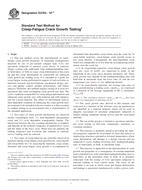
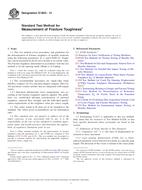 ASTM E1820-13
ASTM E1820-13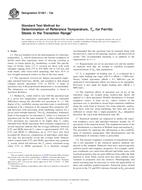 ASTM E1921-13a
ASTM E1921-13a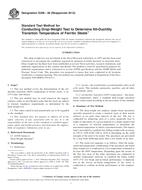 ASTM E208-06(2012)..
ASTM E208-06(2012)..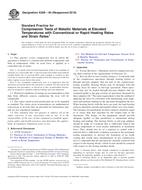 ASTM E209-00(2010)..
ASTM E209-00(2010)..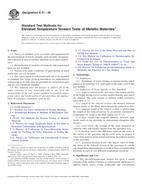 ASTM E21-09
ASTM E21-09 ASTM E2248-13
ASTM E2248-13
 Cookies
Cookies
